Concrete by Preplaced Aggregate Method Using Silica Fume and Polypropylene Fibres
Abstract
:1. Introduction
2. Materials and Methods
2.1. Materials
2.2. Mix Proportions
2.3. Sample Preparation
2.4. Testing Methods
3. Results and Discussion
3.1. Flowability of Grout
3.2. Compressive Strength
3.3. Splitting Tensile Strength
3.4. Mass Loss and Compressive Strength Loss at 250 °C
3.5. Stress-Strain Relationship
4. Conclusions
- SPAC had higher compressive strength than NPAC; the difference in strength was noted to be 22.6% at 28 days. This may be attributed to higher pozzolanic activity and high sample density due to the addition of Silica fume.
- The inclusion of fibres in SPAC led to a reduction in the compressive strength of the cast samples. At 28 days of curing, FRPAC had 17.61% lower compressive strength than SPAC. The loss in compressive strength might be due to the generation of a greater number of voids in the cast samples due to the addition of fibres. Furthermore, higher fibre dosages inhibit the flow of grout in the coarse aggregate skeleton.
- Overall, FRPAC had the highest splitting tensile strength among the three mixes. At the age of 28 days, FRPAC had 37% and 18.9% higher splitting tensile strength values than NPAC and SPAC, respectively. It is evident that the inclusion of PP fibres enhances the deformation capacity of preplaced aggregate concrete. It may be mainly due to the bridging action of the fibres, preventing the formation and spread of microcracks.
- The mass loss in SPAC at 250 °C was 30% greater than that of FRPAC. SPAC suffered a mass loss of 2.34% as compared to 1.76% in FRPAC.
- The compressive strength loss at 250 °C was considerably greater in FRPAC compared to SPAC. SPAC suffered a compressive strength loss of 23.6% compared to 56.6% in FRPAC.
- Stress-strain curves of FRPAC and SPAC showed that FRPAC exhibited greater strain for the amount of stress applied. Hence it could be deduced from these curves that the inclusion of Polypropylene fibres imparted ductile properties in concrete.
Author Contributions
Funding
Institutional Review Board Statement
Informed Consent Statement
Data Availability Statement
Conflicts of Interest
References
- Abdelgader, H.S.; Elgalhud, A.A. Effect of grout proportions on strength of two-stage concrete. Struct. Concr. 2008, 9, 163–170. [Google Scholar] [CrossRef]
- Najjar, M.; Soliman, A.; Nehdi, M. Critical overview of two-stage concrete: Properties and applications. Constr. Build. Mater. 2014, 62, 47–58. [Google Scholar] [CrossRef]
- Abdelgader, H.S. How to design concrete produced by a two-stage concreting method. Cem. Concr. Res. 1999, 29, 331–337. [Google Scholar] [CrossRef]
- Abdul Awal, A.S.M. Manufacture and Properties of Prepacked Aggregate Concrete. Master’s Thesis, University of Melbourne, Melbourne, Australia, March 1984. [Google Scholar]
- Das, K.K.; Lam, E.S.S.; Tang, H.H. Partial replacement of cement by ground granulated blast furnace slag and silica fume in two-stage concrete (preplaced aggregate concrete). Struct. Concr. 2021, 22, E466–E473. [Google Scholar] [CrossRef]
- Amran, Y.H.M.; Alyousef, R.; Alabduljabbar, H.; Khudhair, M.H.R.; Hejazi, F.; Alaskar, A.; Alrshoudi, F.; Siddika, A. Performance properties of structural fibred-foamed concrete. Results Eng. 2020, 5, 100092. [Google Scholar] [CrossRef]
- Stodola, P.R.; Akers, D.; Bennett, J., Jr.; Cheff, A.; Clapp, T.; Cope, J.; Green, D. Guide for the use of preplaced aggregate concrete for structural and mass concrete applications. ACI Mater. J. 1991, 88, 650–668. [Google Scholar]
- Mohammadhosseini, H.; Tahir, M.M.; Alaskar, A.; Alabduljabbar, H.; Alyousef, R. Enhancement of strength and transport properties of a novel preplaced aggregate fiber reinforced concrete by adding waste polypropylene carpet fibers. J. Build. Eng. 2020, 27, 101003. [Google Scholar] [CrossRef]
- Najjar, M.; Nehdi, M.; Soliman, A.; Azabi, T. Damage mechanisms of two-stage concrete exposed to chemical and physical sulfate attack. Constr. Build. Mater. 2017, 137, 141–152. [Google Scholar] [CrossRef]
- O’Malley, J.; Abdelgader, H.S. Investigation into viability of using two-stage (pre-placed aggregate) concrete in Irish setting. Front. Arch. Civ. Eng. China 2010, 4, 127–132. [Google Scholar] [CrossRef]
- Davis, R.E.; Jansen, E.C.; Neelands, W. Restoration of Barker Dam. In Journal Proceedings; American Concrete Institute: Farmington Hills, MI, USA, 1948; Volume 44, pp. 633–668. [Google Scholar]
- Huang, M.; An, X.; Zhou, H.; Jin, F. Rock-filled concrete—Development, investigations and applications. Int. Water Power Dam. Constr. 2008, 60, 20–24. [Google Scholar]
- Malhotra, V. Fly ash, slag, silica fume, and rice husk ash in concrete: A review. Concr. Int. 1993, 15, 23–28. [Google Scholar]
- Najjar, M.F.; Soliman, A.M.; Nehdi, M.L. Two-stage concrete made with single, binary and ternary binders. Mater. Struct. 2014, 49, 317–327. [Google Scholar] [CrossRef]
- Hsie, M.; Tu, C.; Song, P. Mechanical properties of polypropylene hybrid fiber-reinforced concrete. Mater. Sci. Eng. A 2008, 494, 153–157. [Google Scholar] [CrossRef]
- Corinaldesi, V.; Moriconi, G. Use of synthetic fibers in self-compacting lightweight aggregate concretes. J. Build. Eng. 2015, 4, 247–254. [Google Scholar] [CrossRef]
- MMurali, G.; Fediuk, R. A Taguchi approach for study on impact response of ultra-high-performance polypropylene fibrous cementitious composite. J. Build. Eng. 2020, 30, 101301. [Google Scholar] [CrossRef]
- Guerini, V.; Conforti, A.; Plizzari, G.; Kawashima, S. Influence of Steel and Macro-Synthetic Fibers on Concrete Properties. Fibers 2018, 6, 47. [Google Scholar] [CrossRef] [Green Version]
- Svintsov, A.P.; Shchesnyak, E.L.; Galishnikova, V.V.; Fediuk, R.S.; Stashevskaya, N.A. Effect of nano-modified additives on properties of concrete mixtures during winter season. Constr. Build. Mater. 2020, 237, 117527. [Google Scholar] [CrossRef]
- Minelli, F.; Conforti, A.; Cuenca, E.; Plizzari, G. Are steel fibres able to mitigate or eliminate size effect in shear? Mater. Struct. 2013, 47, 459–473. [Google Scholar] [CrossRef]
- Cuenca, E.; Serna, P. Failure modes and shear design of prestressed hollow core slabs made of fiber-reinforced concrete. Compos. Part B Eng. 2013, 45, 952–964. [Google Scholar] [CrossRef]
- Barreto, E.D.S.; Stafanato, K.V.; Marvila, M.T.; de Azevedo, A.R.G.; Ali, M.; Pereira, R.M.L.; Monteiro, S.N. Clay Ceramic Waste as Pozzolan Constituent in Cement for Structural Concrete. Materials 2021, 14, 2917. [Google Scholar] [CrossRef]
- Van Chanh, N. Steel fiber reinforced concrete. In Faculty of Civil Engineering Ho Chi Minh City University of Technology. Seminar Material; Citeseer: Ho Chi Minh City, Vietnam, 2004. [Google Scholar]
- Vairagade, V.S.; Kene, K.S. Introduction to steel fiber reinforced concrete on engineering performance of concrete. Int. J. Sci. Technol. Res. 2012, 1, 141. [Google Scholar]
- Cuenca, E.; Echegaray-Oviedo, J.; Serna, P. Influence of concrete matrix and type of fiber on the shear behavior of self-compacting fiber reinforced concrete beams. Compos. Part B Eng. 2015, 75, 135–147. [Google Scholar] [CrossRef]
- Cuenca, E.; Serna, P. Shear behavior of prestressed precast beams made of self-compacting fiber reinforced concrete. Constr. Build. Mater. 2013, 45, 145–156. [Google Scholar] [CrossRef] [Green Version]
- Chalioris, C. Analytical approach for the evaluation of minimum fibre factor required for steel fibrous concrete beams under combined shear and flexure. Constr. Build. Mater. 2013, 43, 317–336. [Google Scholar] [CrossRef]
- Ramakrishnan, V.; Tolmare, N.S.; Brik, V.B. Performance Evaluation of 3-D Basalt Fiber Reinforced Concrete & Basalt Rod Reinforced Concrete (No. NCHRP-IDEA Project 45); Transportation Research Board: Washington, DC, USA, 1998. [Google Scholar]
- Amran, Y.M. Influence of structural parameters on the properties of fibred-foamed concrete. Innov. Infrastruct. Solut. 2020, 5, 16. [Google Scholar] [CrossRef]
- High, C.; Seliem, H.M.; El-Safty, A.; Rizkalla, S.H. Use of basalt fibers for concrete structures. Constr. Build. Mater. 2015, 96, 37–46. [Google Scholar] [CrossRef]
- Patel, J.; Desai, N.; Rana, J. Properties and Application of Steel Polypropylene and Polyester Fibre Reinforced Concrete. Fibre Reinforced Cements and Concretes: Recent Developments. Proceedings of an International Conference Held at the University of Wales, College of Cardiff, School of Engineering, United Kingdom, 18–20 September 1989; Elsevier Applied Science Publishers Limited: Essex, UK, 1989. [Google Scholar]
- Pelisser, F.; Montedo, O.R.K.; Gleize, P.; Roman, H.R. Mechanical properties of recycled PET fibers in concrete. Mater. Res. 2012, 15, 679–686. [Google Scholar] [CrossRef]
- Fraternali, F.; Ciancia, V.; Chechile, R.; Rizzano, G.; Feo, L.; Incarnato, L. Experimental study of the thermo-mechanical properties of recycled PET fiber-reinforced concrete. Compos. Struct. 2011, 93, 2368–2374. [Google Scholar] [CrossRef]
- Ali, B.; Qureshi, L.A. Influence of glass fibers on mechanical and durability performance of concrete with recycled aggregates. Constr. Build. Mater. 2019, 228, 116783. [Google Scholar] [CrossRef]
- Loos, F.; Verpoest, I.; Müssig, J.; Hughes, M.; Lomov, S.V.; Baley, C.; Davies, P.; Baets, J.; Ziegmann, G.; Elsabbagh, A.; et al. Flax and Hemp Fibres: A Natural Solution for the Composite Industry; CELC Technical Section and JEC Group: Paris, France, 2012. [Google Scholar]
- Page, J.; Khadraoui, F.; Boutouil, M.; Gomina, M. Multi-physical properties of a structural concrete incorporating short flax fibers. Constr. Build. Mater. 2017, 140, 344–353. [Google Scholar] [CrossRef]
- Wang, J.; Dai, Q.; Si, R.; Guo, S. Mechanical, durability, and microstructural properties of macro synthetic polypropylene (PP) fiber-reinforced rubber concrete. J. Clean. Prod. 2019, 234, 1351–1364. [Google Scholar] [CrossRef]
- Kim, S.B.; Yi, N.H.; Kim, H.Y.; Kim, J.-H.J.; Song, Y.-C. Material and structural performance evaluation of recycled PET fiber reinforced concrete. Cem. Concr. Compos. 2010, 32, 232–240. [Google Scholar] [CrossRef]
- Ochi, T.; Okubo, S.; Fukui, K. Development of recycled PET fiber and its application as concrete-reinforcing fiber. Cem. Concr. Compos. 2007, 29, 448–455. [Google Scholar] [CrossRef]
- Grzybowski, M.; Shah, S.P. Shrinkage cracking of fiber reinforced concrete. Mater. J. 1990, 87, 138–148. [Google Scholar]
- Alhozaimy, A.; Soroushian, P.; Mirza, F. Mechanical properties of polypropylene fiber reinforced concrete and the effects of pozzolanic materials. Cem. Concr. Compos. 1996, 18, 85–92. [Google Scholar] [CrossRef]
- Abdelgader, H.; Fediuk, R.; Kurpińska, M.; Elkhatib, J.; Murali, G.; Baranov, A.V.; Timokhin, R.A. Mechanical properties of two-stage concrete modified by silica fume. Mag. Civ. Eng. [Инженернo-Стрoительный Журнал (Inzhenerno-Stroit. Zhurnal)] 2019, 89, 26–38. [Google Scholar]
- Oderji, S.Y.; Chen, B.; Ahmad, M.R.; Shah, S.F.A. Fresh and hardened properties of one-part fly ash-based geopolymer binders cured at room temperature: Effect of slag and alkali activators. J. Clean. Prod. 2019, 225, 1–10. [Google Scholar] [CrossRef]
- Trimurtiningrum, R.; Ekaputri, J.J. Geopolymer Grout Material. Mater. Sci. Forum 2016, 841, 40–47. [Google Scholar] [CrossRef]
- Murali, G.; Ramprasad, K. A feasibility of enhancing the impact strength of novel layered two stage fibrous concrete slabs. Eng. Struct. 2018, 175, 41–49. [Google Scholar] [CrossRef]
- Yermak, N.; Pliya, P.; Beaucour, A.-L.; Simon, A.; Noumowé, A. Influence of steel and/or polypropylene fibres on the behaviour of concrete at high temperature: Spalling, transfer and mechanical properties. Constr. Build. Mater. 2017, 132, 240–250. [Google Scholar] [CrossRef]
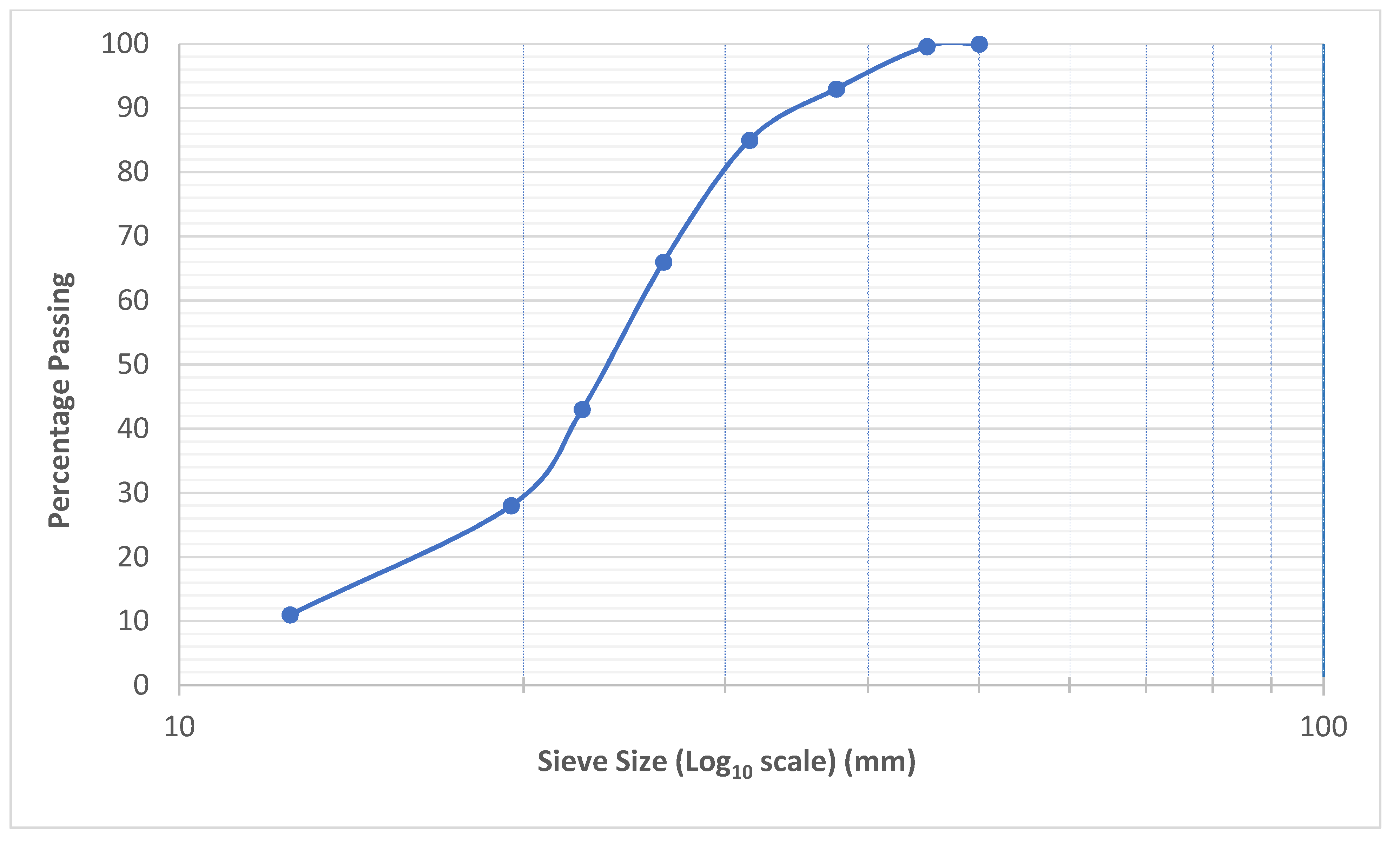
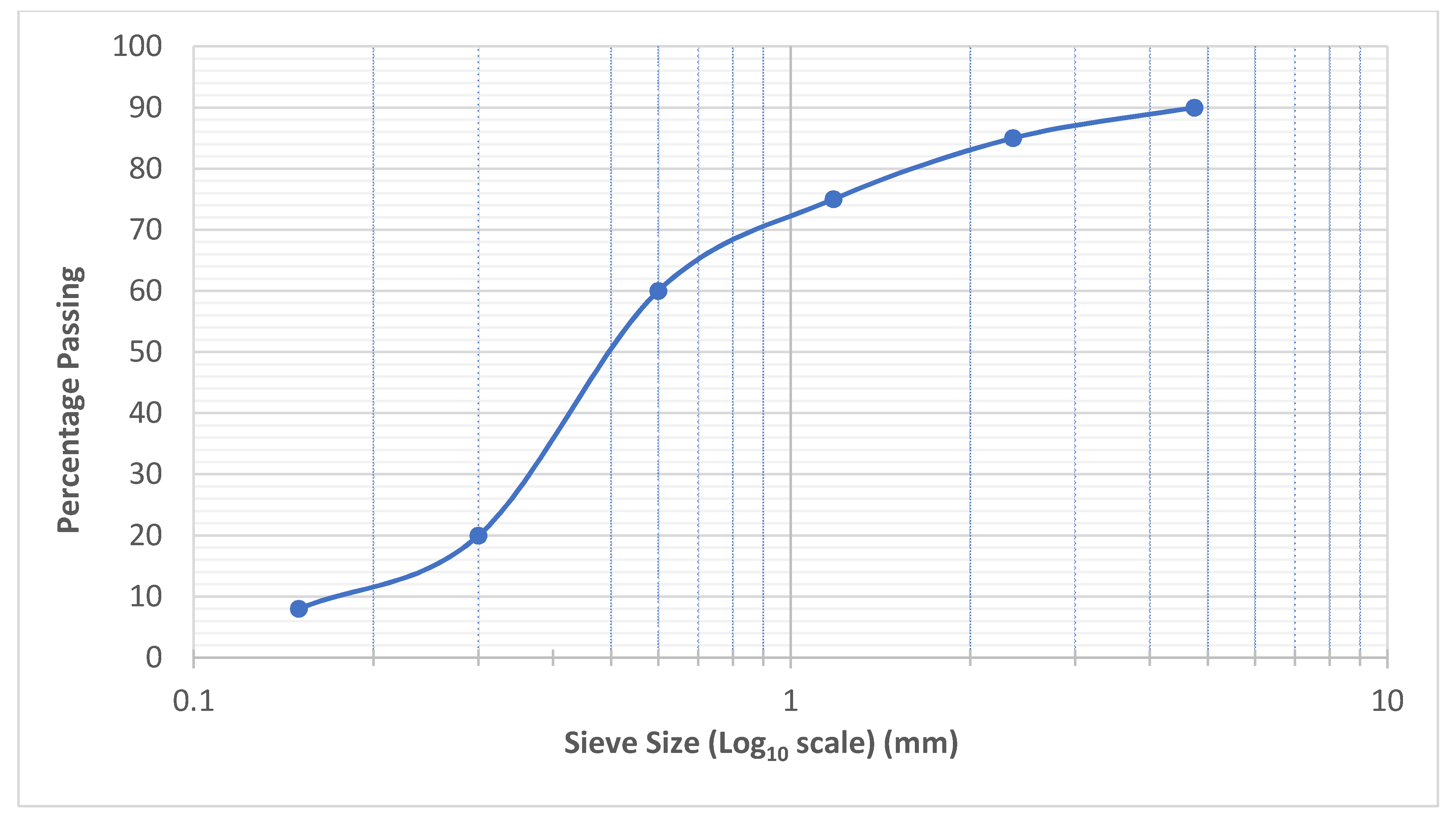
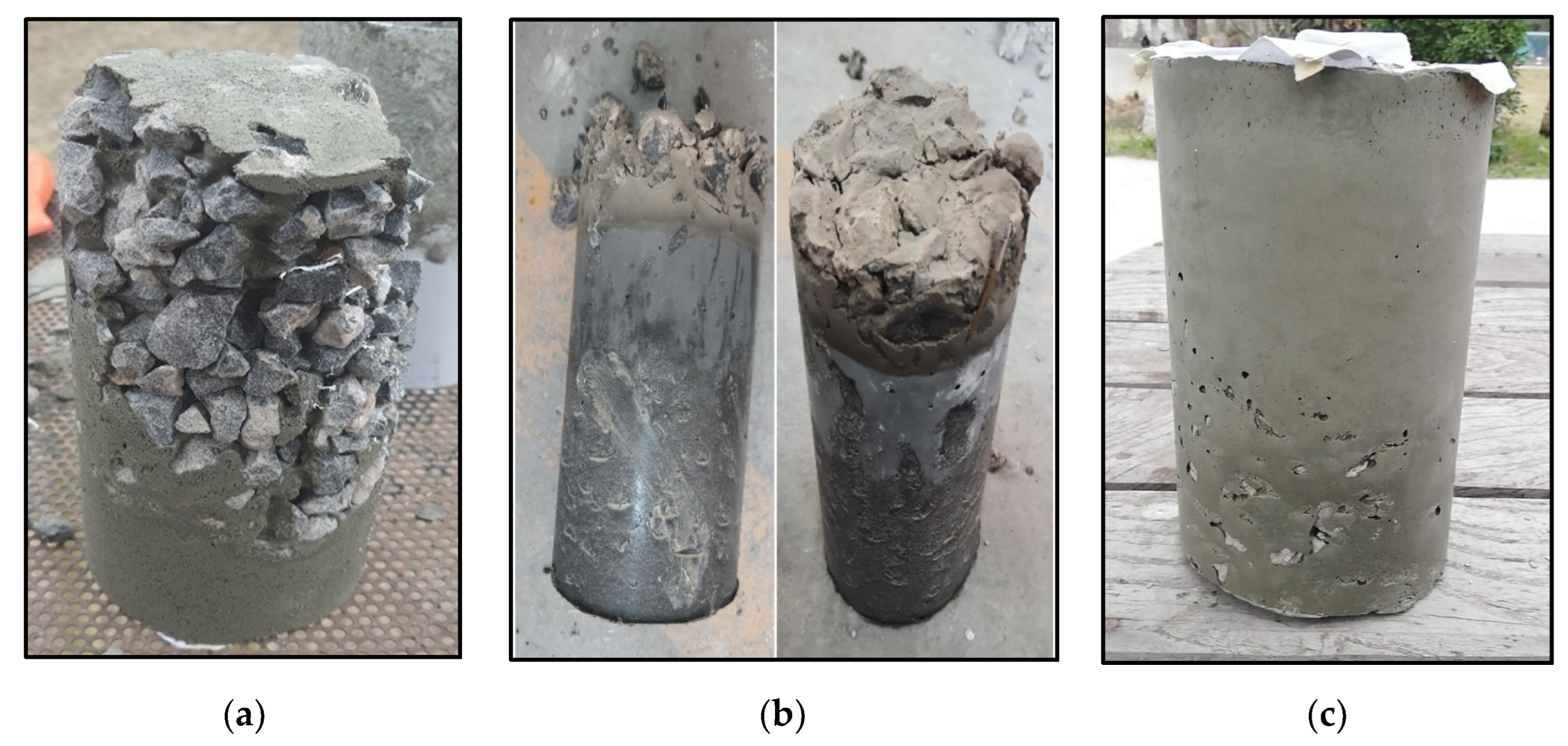
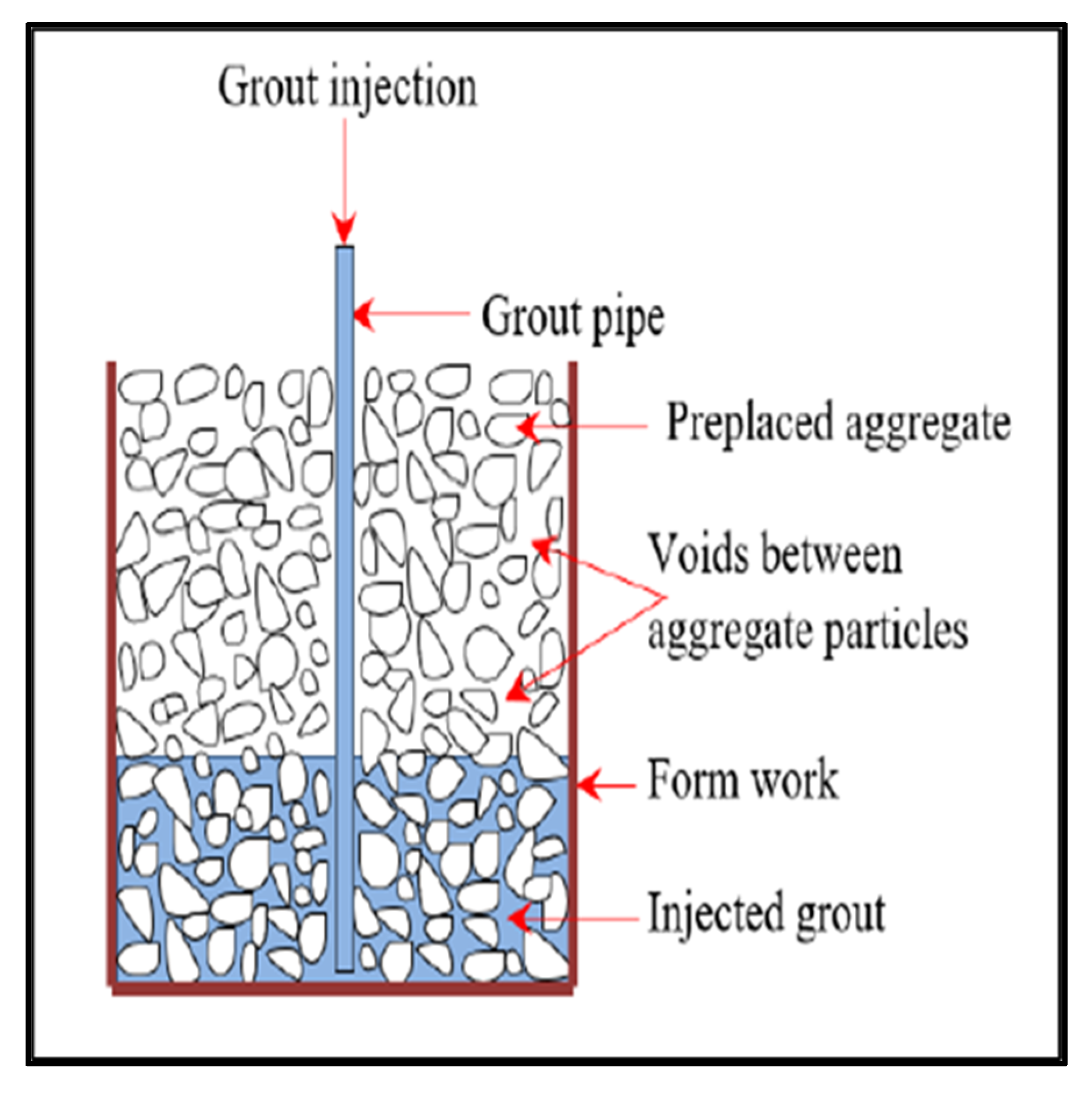
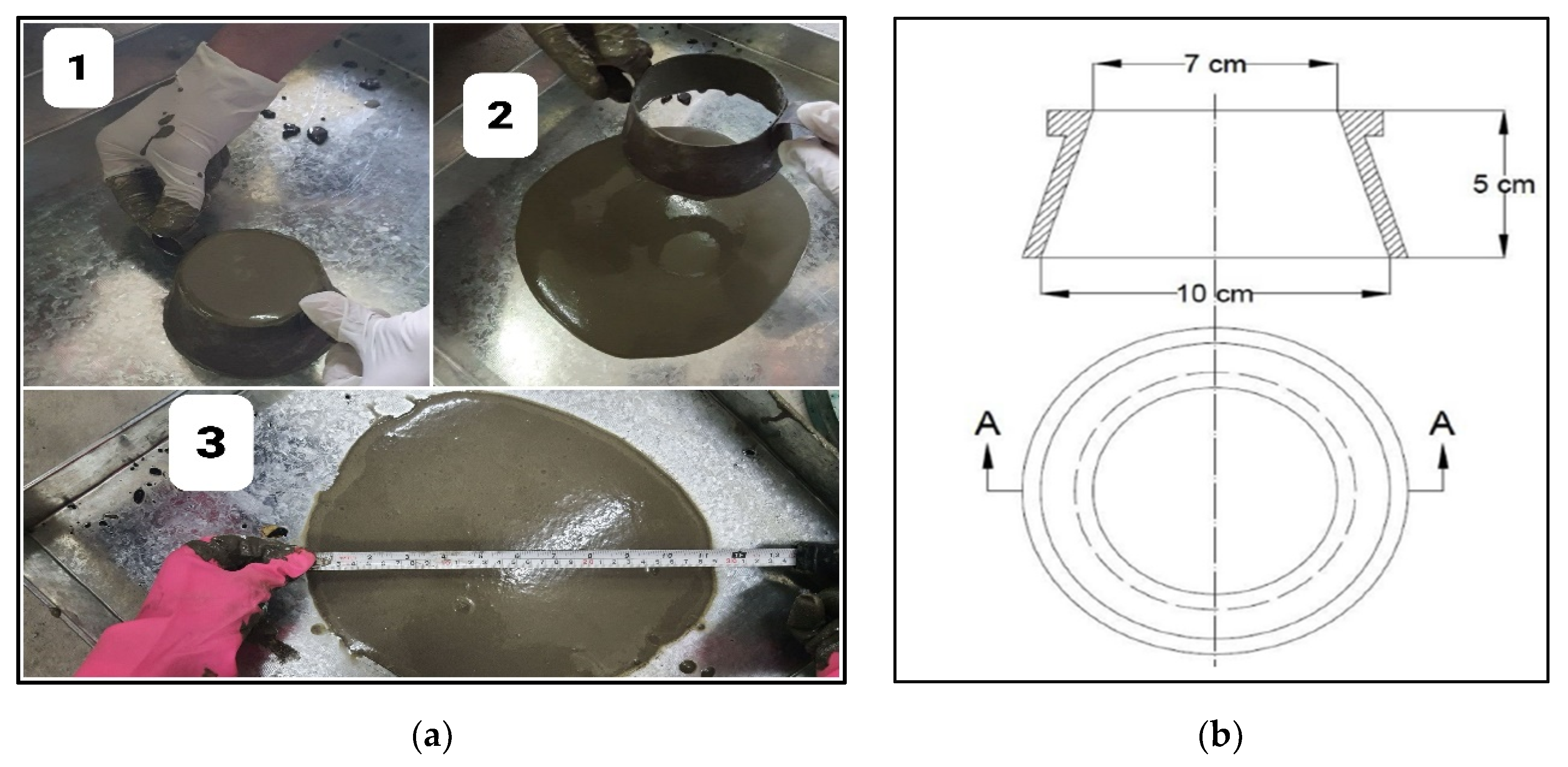

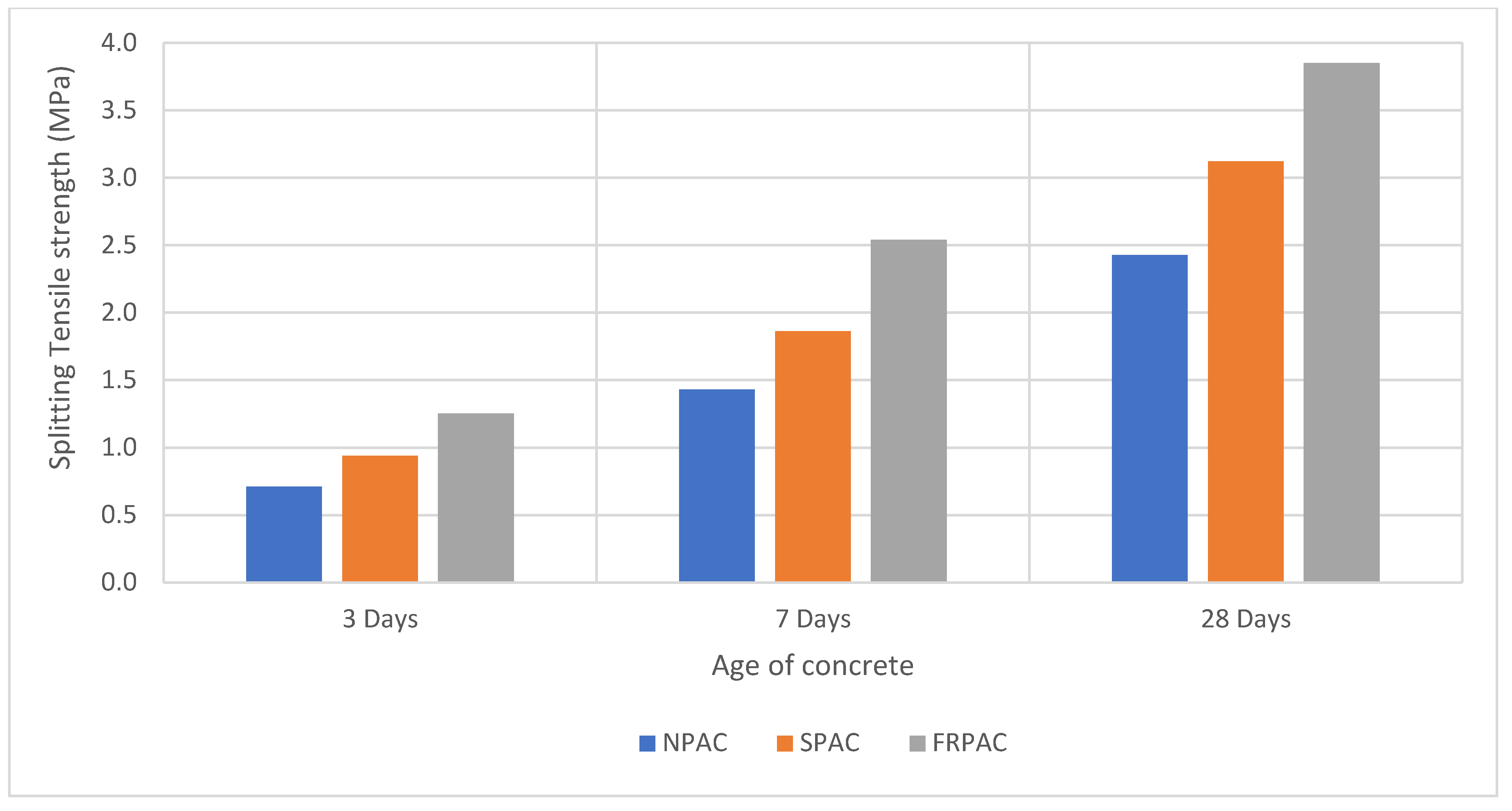
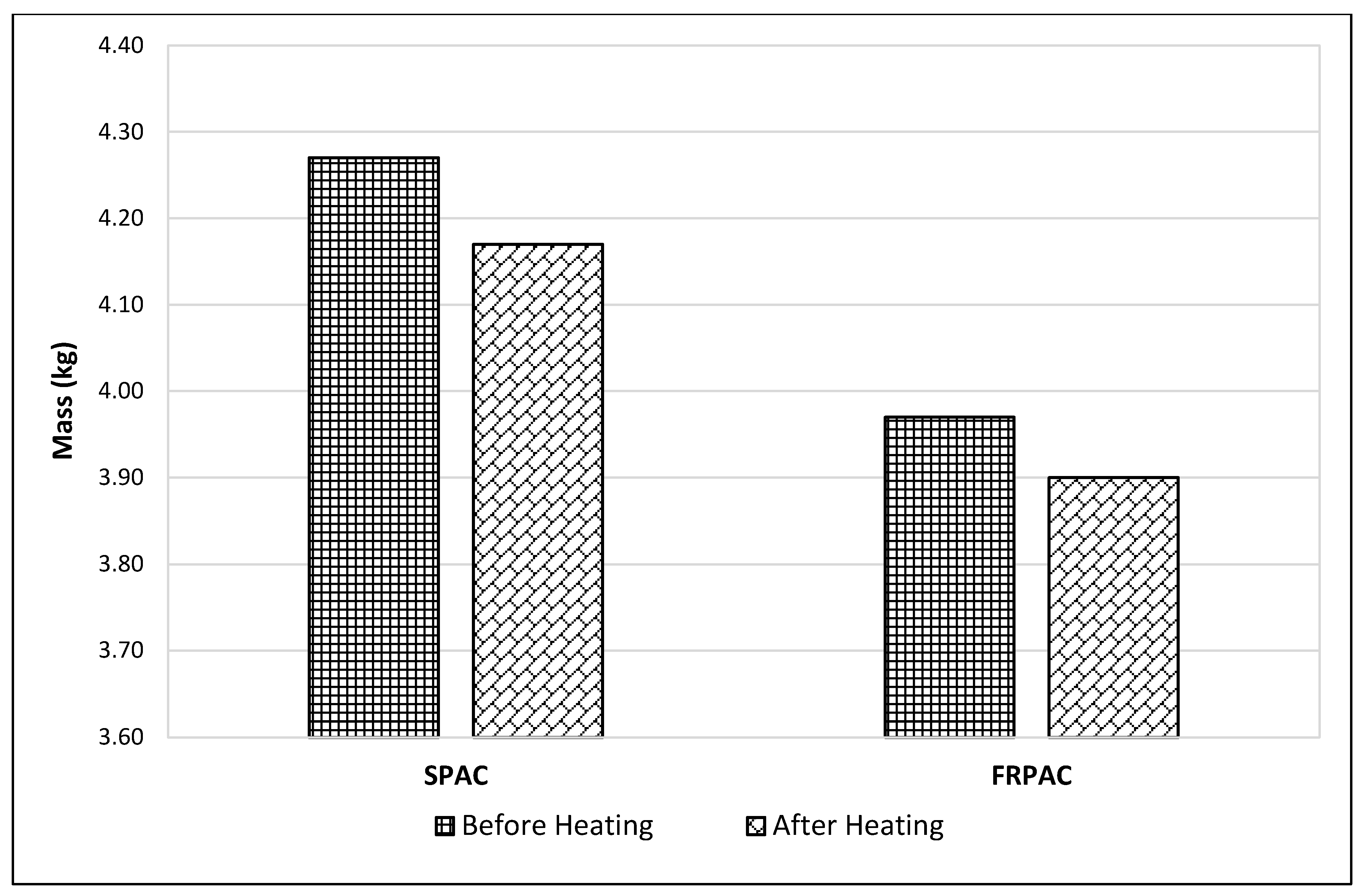
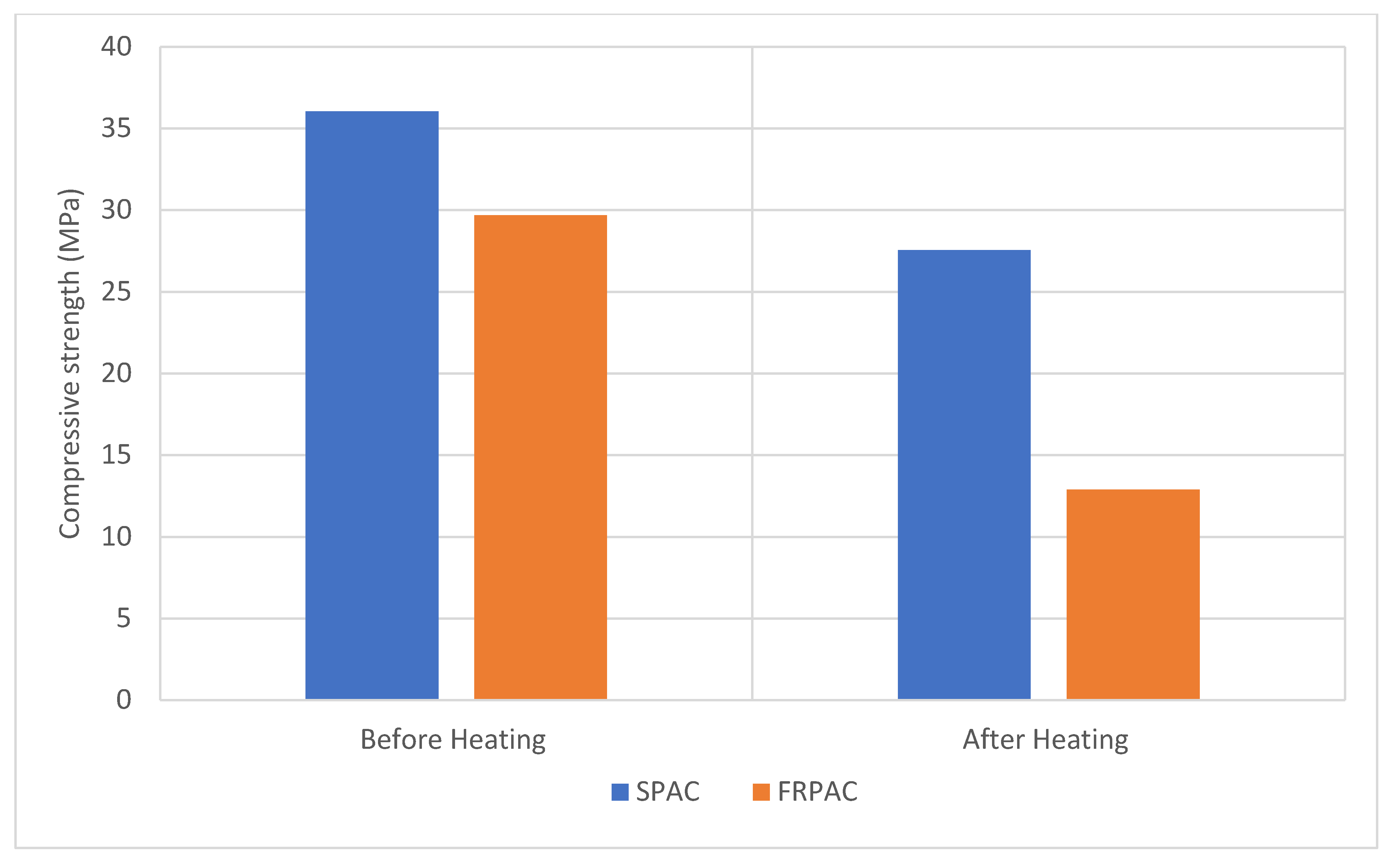

| Chemical Composition | Percentage | ASTM C618 Requirement |
|---|---|---|
| SiO2 | 97.323 | SiO2 + Fe2O3 + Al2O3 > 70% |
| Fe2O3 | 0.044 | |
| Al2O3 | 0.003 | |
| SO3 | 2.043 | - |
| K2O | 0.545 | - |
| MnO | 0.016 | - |
| CuO | 0.015 | - |
| Property | Value | Standard Used |
|---|---|---|
| Compressive strength (MPa) | 38–55 | ASTM D695 |
| Flexural strength (MPa) | 41–56 | ASTM D790 |
| Tensile strength at break (MPa) | 31–42 | ASTM D638 |
| Elongation at break (%) | 100–600 | ASTM D638 |
| Water absorption (%) | Negligible (0.01–0.03) | ASTM D570 |
| Specific Gravity | 0.90–0.91 | ASTM D792 |
| Ignition point | 593 °C | - |
| Melting Point | 160–170 °C | - |
| Heat and UV stabilisation | Long Term | - |
| Thermal Conductivity | 2.8 × 10−4 Cal cm/s cm2 °C | ASTM C177 |
| Tensile Modulus (MPa) | 1140–1560 | ASTM D638 |
| Compressive modulus (MPa) | 1030–2070 | ASTM D695 |
| Flexural Modulus (MPa @ 25 °C) | 1170–1730 | ASTM D790 |
| Rockwell hardness | R80–R102 | ASTM D785 |
| Electrical Conductivity | Low | - |
| Salt Resistance | High | - |
| Acid Resistance | High | - |
| Alkali Resistance | 100% (alkali proof) | - |
| S. No | S/B | W/B | SP Dosage (% by Weight of Binder) | SP Model | Flowability (mm) | Comments | Three-Day Compressive Strength (MPa) |
|---|---|---|---|---|---|---|---|
| 1 | 0.5 | 0.4 | 2 | Chemrite AG 300 | 712 | Flowability of grout too high | - |
| 2 | 0.5 | 0.4 | 1 | AG 300 | 585 | Flowability of grout too high | - |
| 3 | 0.5 | 0.37 | 0 | AG 300 | 102 | Grout too thick | - |
| 4 | 0.5 | 0.37 | 0.1 | AG 300 | 114 | Grout too thick | - |
| 5 | 0.5 | 0.37 | 0.15 | AG 300 | 120 | Grout too thick | - |
| 6 | 0.5 | 0.37 | 0.175 | AG 300 | 123 | Grout too thick | - |
| 7 | 0.5 | 0.37 | 0.2 | AG 300 | 127 | Grout too thick | - |
| 8 | 0.5 | 0.37 | 0.225 | AG 300 | 153 | Grout too thick | - |
| 9 | 0.5 | 0.37 | 0.25 | AG 300 | 178 | Grout too thick | - |
| 10 | 0.5 | 0.37 | 0.275 | AG 300 | 204 | Grout too thick | - |
| 11 | 0.5 | 0.37 | 0.3 | AG 300 | 229 | Grout too thick | - |
| 12 | 0.5 | 0.37 | 0.325 | AG 300 | 254 | Grout too thick | - |
| 13 | 0.5 | 0.37 | 0.35 | AG 300 | 305 | Sufficient flowability of grout | 13.75 |
| 14 | 0.5 | 0.37 | 0.375 | AG 300 | 356 | Flowability of grout too high | - |
| 15 | 0.5 | 0.37 | 0.4 | AG 300 | 394 | Flowability of grout too high | - |
| 16 | 0.5 | 0.37 | 0.425 | AG 300 | 432 | Flowability of grout too high | - |
| 17 | 0.5 | 0.37 | 0.45 | AG 300 | 483 | Flowability of grout too high | - |
| 18 | 0.5 | 0.37 | 0.475 | AG 300 | 508 | Flowability of grout too high | - |
| 19 | 0.5 | 0.37 | 0.5 | AG 300 | 534 | Flowability of grout too high | - |
| 20 | 1 | 0.37 | 0.35 | AG 300 | 178 | Grout too thick | - |
| 21 | 1 | 0.37 | 0.5 | AG 300 | 204 | Grout too thick | - |
| 22 | 1 | 0.37 | 0.75 | AG 300 | 229 | Grout too thick | - |
| 23 | 1 | 0.37 | 0.8 | AG 300 | 242 | Grout too thick | - |
| 24 | 1 | 0.37 | 1 | AG 300 | 280 | Sufficient flowability | 16.23 |
| 25 | 1.5 | 0.37 | 0.35 | AG 300 | 115 | Grout too thick | - |
| 26 | 2 | 0.37 | 2 | AG 300 | 102 | Grout too thick | - |
| 27 | 2 | 0.4 | 2 | AG 300 | 140 | Grout too thick | - |
| 28 | 2 | 0.45 | 2 | AG 300 | 191 | Grout too thick | - |
| 29 | 2 | 0.47 | 2 | AG 300 | 216 | Grout too thick | - |
| 30 | 2 | 0.5 | 2 | AG 300 | 254 | Grout too thick | - |
| S. No | S/B | W/B | Silica Fume (%Age by Weight of Binder) | SP dosage (% by Weight of Binder) | SP Model | Flowability (mm) | Comments | Three-Day Compressive Strength (MPa) |
|---|---|---|---|---|---|---|---|---|
| 1 | 1 | 0.37 | 5 | 1 | AG 300 | 280 | Sufficient flowability | 17.87 |
| 2 | 1 | 0.37 | 10 | 1 | AG 300 | 229 | Grout too thick | - |
| 3 | 1 | 0.38 | 10 | 1 | AG 300 | 254 | Grout too thick | - |
| 4 | 1 | 0.39 | 10 | 1 | AG 300 | 280 | Sufficient flowability | 19.73 |
| 5 | 1 | 0.39 | 15 | 1 | AG 300 | 242 | Grout too thick | - |
| 6 | 1 | 0.41 | 15 | 1 | AG 300 | 267 | Grout too thick | - |
| 7 | 1 | 0.41 | 20 | 1 | AG 300 | 166 | Grout too thick | - |
| 8 | 1 | 0.45 | 20 | 1 | AG 300 | 254 | Grout too thick | - |
| S. No | S/B | W/B | Silica Fume (%Age by Weight of Binder) | SP Dosage (% by Weight of Binder) | Fibre Type | Fibre Content (% by the Total Volume of Mould) | Flowability (mm) | Compressive Strength (MPa) |
|---|---|---|---|---|---|---|---|---|
| 1 | 1 | 0.39 | 10 | 1 | Mono | 1 | 280 | - |
| 2 | 1 | 0.39 | 10 | 1 | Mono | 1.5 | 280 | - |
| 3 | 1 | 0.45 | 10 | 1 | Mono | 1 | 294 | - |
| 4 | 1 | 0.45 | 10 | 1 | Mono | 1.5 | 294 | - |
| 5 | 1 | 0.45 | 10 | 1 | Macro | 1 | 294 | - |
| 6 | 1 | 0.45 | 10 | 1 | Macro | 1.5 | 294 | - |
| 7 | 1 | 0.45 | 10 | 1 | Fibrillated | 1 | 294 | - |
| 8 | 1 | 0.45 | 10 | 1 | Fibrillated | 1.5 | 294 | - |
| 9 | 1 | 0.5 | 10 | 1 | Mono | 1.5 | 311 | - |
| 10 | 1 | 0.55 | 10 | 1 | Mono | 1.5 | 332 | - |
| 11 | 1 | 0.65 | 10 | 1 | Mono | 1.5 | 375 | - |
| 12 | 1 | 0.7 | 10 | 1 | Mono | 1.5 | 388 | - |
| 13 | 1 | 0.8 | 10 | 1 | Mono | 1.5 | 409 | - |
| 14 | 1 | 0.6 | 10 | 1 | Mono | 1 | 356 | 11.1 |
| 15 | 1 | 0.6 | 10 | 1 | Mono | 1.5 | 356 | 9.78 |
| 16 | 1 | 0.6 | 10 | 1 | Macro | 1 | 356 | 9.96 |
| 17 | 1 | 0.6 | 10 | 1 | Macro | 1.5 | 356 | 13.56 |
| 18 | 1 | 0.6 | 10 | 1 | Fibrillated | 1 | 356 | 13.32 |
| 19 | 1 | 0.6 | 10 | 1 | Fibrillated | 1.5 | 356 | 11.85 |
| Name | S/B | W/B | Silica Fume (%Age by Weight of Binder) | SP Dosage (% by Weight of Binder) | Fibre Type | Fibre Content (% by the Total Volume of Mould) |
|---|---|---|---|---|---|---|
| NPAC | 1 | 0.6 | 0 | 1 | - | - |
| SPAC | 1 | 0.6 | 10 | 1 | - | - |
| FRPAC | 1 | 0.6 | 10 | 1 | Macro | 1.5 |
Publisher’s Note: MDPI stays neutral with regard to jurisdictional claims in published maps and institutional affiliations. |
© 2022 by the authors. Licensee MDPI, Basel, Switzerland. This article is an open access article distributed under the terms and conditions of the Creative Commons Attribution (CC BY) license (https://creativecommons.org/licenses/by/4.0/).
Share and Cite
Khanzada, F.A.; Nazir, K.; Ishtiaq, M.; Javed, M.F.; Kashif-ur-Rehman, S.; Aslam, F.; Musarat, M.A.; Usanova, K.I. Concrete by Preplaced Aggregate Method Using Silica Fume and Polypropylene Fibres. Materials 2022, 15, 1997. https://doi.org/10.3390/ma15061997
Khanzada FA, Nazir K, Ishtiaq M, Javed MF, Kashif-ur-Rehman S, Aslam F, Musarat MA, Usanova KI. Concrete by Preplaced Aggregate Method Using Silica Fume and Polypropylene Fibres. Materials. 2022; 15(6):1997. https://doi.org/10.3390/ma15061997
Chicago/Turabian StyleKhanzada, Farooq Azam, Kashif Nazir, Muhammad Ishtiaq, Muhammad Faisal Javed, Sardar Kashif-ur-Rehman, Fahid Aslam, Muhammad Ali Musarat, and Kseniia Iurevna Usanova. 2022. "Concrete by Preplaced Aggregate Method Using Silica Fume and Polypropylene Fibres" Materials 15, no. 6: 1997. https://doi.org/10.3390/ma15061997
APA StyleKhanzada, F. A., Nazir, K., Ishtiaq, M., Javed, M. F., Kashif-ur-Rehman, S., Aslam, F., Musarat, M. A., & Usanova, K. I. (2022). Concrete by Preplaced Aggregate Method Using Silica Fume and Polypropylene Fibres. Materials, 15(6), 1997. https://doi.org/10.3390/ma15061997










